Michigan hop update – June 6, 2014
Growers should be scouting for downy mildew, two-spotted spider mites and potato leafhopper this week. MSU Extension will be tracking hop development this season and providing growers with relevant pest management information.
Hop bines around Michigan are really taking off with the ample rain and some warmer weather. Bines vary in height, but average 5 feet in Northwest Michigan this week. Growing degree day (GDD) accumulation is significantly different along the western portion of the state where the majority of hop acreage is located.
So far this season, the Benton Harbor Enviro-weather station has accumulated 494 GDD50 with 0.21 inches of rain over the past week; the Clarksville Enviro-weather station has recorded 430 GDD50 with 0.3 inches of rain; the Bear Lake Enviro-weather station has accumulated 343 GDD50 with 0.65 inches of rain; and the Northwest Michigan Horticultural Research Center has accumulated 317 GDD50 with just under 0.94 inches of rain. Despite significant rainfall in some locations, growers continue to irrigate to meet the substantial water demands of hops. Some planting, stringing and training is still underway. Cover crops in row middles planted this spring seem to be faring well, likely helped along by the protracted cool and wet spring.
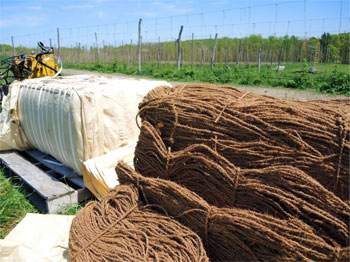
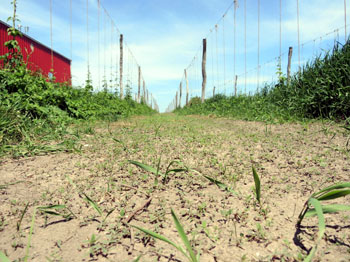
Left, Coconut coir string is hung in a Northwest Michigan hopyard. Right, Rye, peas and clover seeded this spring have germinated well with the cool and wet spring weather. Photo credits: Erin Lizotte, MSU Extension
After seeing significant downy mildew infection in 2013, many growers applied early protectant sprays as basal spikes emerged this spring. Despite applying protectant fungicides, some Michigan growers have reported active downy mildew infections. Downy mildew is caused by Pseudoperonospora humuli and can cause significant yield and quality losses depending on variety and when infection becomes established. In extreme cases, cones can become infected and the crown may die.
Downy mildew overwinters in dormant buds or crowns, moving into buds during early spring and then into the tissue of the basal spikes as shoots expand. The pathogen produces copious spores on the underside of infected leaves. According to “Field Guide for Integrated Pest Management in Hops,” infection is favored by mild to warm temperatures – 60 to 70 degrees Fahrenheit – when free moisture is present for at least 1.5 hours. Leaf infection can occur at temperatures as low as 41 F when wetness persists for 24 hours or longer.
Typically, downy mildew appears early in the season on the emerging basal spikes. Spikes appear stunted, brittle and distorted. Infected leaves have angular, water-soaked lesions that follow leaf venation. The water-soaked lesions turn brown and necrotic with fuzzy and grayish black asexual spore masses developing on the underside of leaf lesions. As bines grow, new tissue becomes infected and fails to climb the string. Growers can attempt to retrain new shoots, but often incur yield loss as a result.
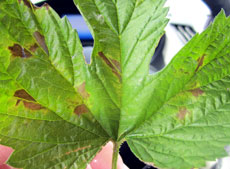
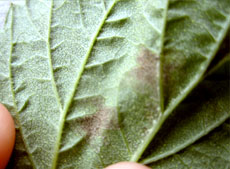
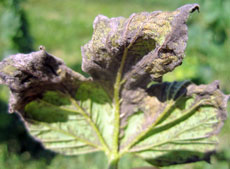
(Left) Angular downy mildew lesions. (Middle) Grayish brown fuzzy appearance of downy mildew fungus on the underside of a hop leaf. (Right) Advanced downy mildew infection on the underside of the leaf. Photo credits: Erin Lizotte, MSU Extension
It takes a multipronged approach to manage for downy mildew. Although cultural practices alone are not enough to manage downy mildew, plant cultivars more tolerant to downy mildew when possible. Clean planting materials should be selected when establishing new hopyards since this disease is readily spread via nursery stock. Establish good sanitation practices. Pull all basal foliage during spring pruning. Remove it from the hopyard and bury or burn it to reduce inoculum. If you already have downy mildew established in your hopyard, cultural practices will be very important in regaining ground as the season progresses. According to Oregon State University, diseased shoots on the string should be removed by hand and healthy shoots retrained in their place. Remove superfluous basal foliage and lower leaves to promote air movement in the canopy and to reduce the duration of wetting periods. If there is a cover crop, it should be mowed close to the ground. If yards have no cover crop, cultivation can help to dry the soil and minimize humidity. Keep nitrogen applications moderate.
Growers should utilize protectant fungicides to mitigate the risks of early and severe infections. Protectant fungicide strategies are particularly important during the year of planting to minimize crown infection and limit disease levels in the future. Well-timed fungicide applications just after the first spikes emerge and before pruning can significantly reduce infection levels season long. Subsequent fungicide applications should be made in response to favorable environmental conditions for downy mildew, such as temperatures above 41 F and wetting events. Fungicides have varying activity against downy mildew. For organic growers, OMRI-approved copper formulations are the most effective.
Some growers have already spotted downy mildew in Michigan hopyards this season, including those applying protectant applications of Aliette. Washington State University has documented resistance of hop downy mildew to fosetyl-Al, the active ingredient in Aliette. Based on these findings, growers are cautioned from relying solely on Aliette for downy management. For a complete list of fungicides labeled for the control of downy mildew on hop, refer to “Pesticides registered for use on hops in Michigan 2014” from Michigan State University Extension.
It is important that growers do not mistake downy mildew for powdery mildew (see photo below for clarification) as the effective pesticide classes are completely different. Powdery mildew has not been confirmed in Michigan and is caused by Podosphaera macularis, a completely different pathogen than that which causes downy mildew.
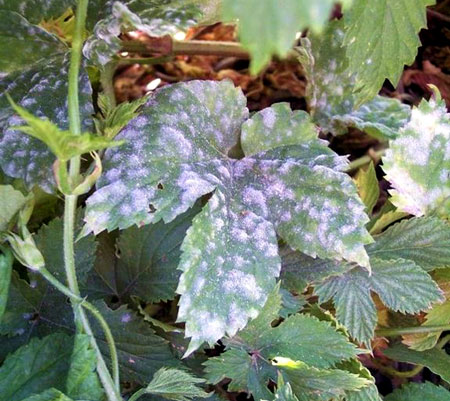
Round, white colonies of the powdery mildew fungus on the upper surface of hop leaves. Photo credit: David Gent, USDA-ARS, Bugwood.org
With significant leaf tissue present, many growers have begun scouting for mites. Two-spotted spider mites are a significant pest of hops in Michigan and can cause serious economic crop loss when high numbers occur. Mites decrease the photosynthetic ability of the leaves and cause direct mechanical damage to the hop cones. Two-spotted spider mites feed on the sap in plant cells. Leaves look stippled or bleached, and webbing may also be present; bines will eventually defoliate under high two-spotted spider mite pressure. Intense infestations weaken the plant and reduce yield and quality. Infested cones develop a reddish discoloration, do not hold up to the drying process, and commonly have lower alpha levels and shorter storage potential. Additionally, the mites themselves act as a contaminant issue for brewers.
In the spring, only female two-spotted spider mites are present. They have overwintered in a dormant stage on debris and trellis structures in the hopyard and are already mated and ready to lay fertilized eggs. They may appear particularly orange in color this time of the year. As temperatures warm, the females feed and begin laying eggs. Depending on temperatures, eggs hatch in two to five days and develop into adults in one to three weeks. Two-spotted spider mites like it hot with the pace of development increasing until an upper threshold is reached around 100 F. Conversely, cold and wet weather slows development.
Two-spotted spider mites can be seen on the underside of leaves using a hand lens. As the season progresses, cast skins and old webbing give infested leaves a dusty and dirty appearance. The eggs look like tiny, clear spheres and are found near adults and larvae. The larvae themselves are small, translucent versions of the adults. Adults change from orange to translucent, yellow or green as they feed. Adults also have two dark spots. When scouting, watch for beneficial, predatory mites that feed on two-spotted spider mites. Predatory mites are often translucent, faster moving and larger than two-spotted spider mites. Predatory mites play an important role in balancing the two-spotted spider mite population and should be protected when possible.
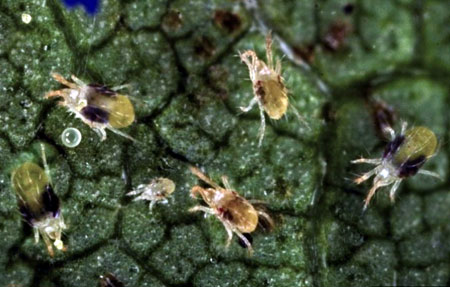
Two-spotted spider mite eggs, larvae and adults (the adult females are the largest followed by the males). Photo credit: David Cappaert, Bugwood.org
Growers should be scouting for mites now and consider cultural and chemical intervention only when mites reach an economic threshold. Take leaf samples from all portions of the bines. Use a hand lens to evaluate two leaves from 20 plants per yard. More than two adult mites per leaf in June indicate the need to implement a pest management strategy. By mid-July, the threshold increases to five to 10 mites per leaf. If cones are not infested, hop plants can tolerate a good deal of damage from mites.
Many factors affect two-spotted spider mite levels, including the presence of beneficials, rainfall and temperatures. Select insecticides that conserve beneficial insects and apply pesticides for mite control only when necessary. Specifically, pyrethroid applications flare mite populations in the hopyard due to their negative impact on beneficial insects.
Lastly, be on the lookout for potato leafhoppers this week as storm systems move through from the Gulf region. So far, we have not heard reports nor observed potato leafhoppers in the North, but they have been reported in the southern portion of the state on other crops. Potato leafhoppers move sideways when disturbed. Adults and nymphs are wedge-shaped and fluorescent green. Adults have white eyes. Some very small nymphs are colorless, but have the characteristic shape of the larger nymphs when viewed using a hand lens.
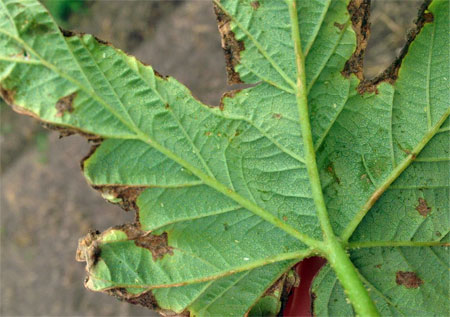
Potato leafhopper nymphs and adults on the underside of a hop leaf exhibiting necrotic “hopper burn” symptoms around the leaf margin. Photo credit: Erin Lizotte, MSU Extension
Although hop plants are susceptible to potato leafhoppers, they can tolerate some feeding and growers should use insecticides sparingly. Potato leafhoppers cause “hopper burn.” Symptoms include a necrosis of the leaf margin in a V-shaped pattern and yellowed or stunted leaves. As a quick spot check, agitate the bines and look for adults to take flight. Confirm their presence and prevalence by looking for adults and wingless nymphs on the underside of leaves. If needed, treat for potato leafhoppers with products containing neonicitinoids, pyrethroids, organophosphates or spinosyns. Organic growers can utilize Entrust (spinosad) or Pyganic (pyrethrin) formulations that are OMRI-approved for potato leafhoppers management. Refer to “Pesticides registered for use on hops in Michigan” for a complete list of registered products.



 Print
Print Email
Email




